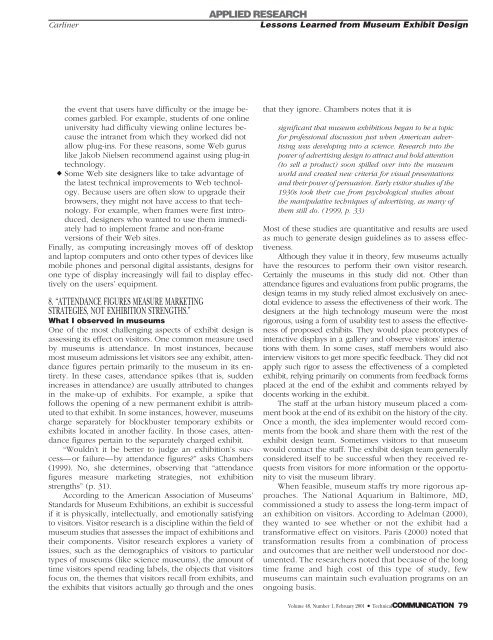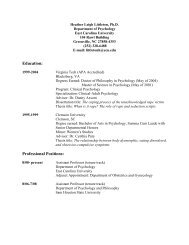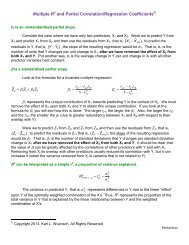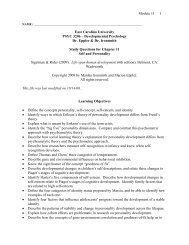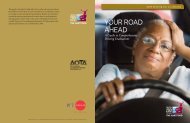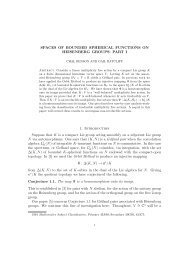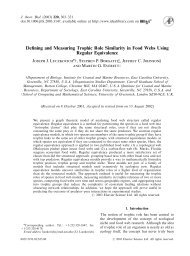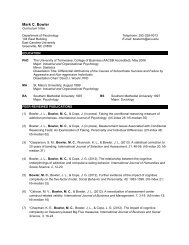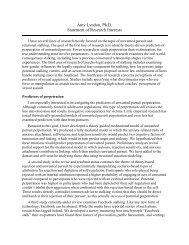Modeling Information for Three-Dimensional Space - Ecu
Modeling Information for Three-Dimensional Space - Ecu
Modeling Information for Three-Dimensional Space - Ecu
Create successful ePaper yourself
Turn your PDF publications into a flip-book with our unique Google optimized e-Paper software.
Carliner<br />
APPLIED RESEARCH<br />
Lessons Learned from Museum Exhibit Design<br />
the event that users have difficulty or the image becomes<br />
garbled. For example, students of one online<br />
university had difficulty viewing online lectures because<br />
the intranet from which they worked did not<br />
allow plug-ins. For these reasons, some Web gurus<br />
like Jakob Nielsen recommend against using plug-in<br />
technology.<br />
Some Web site designers like to take advantage of<br />
the latest technical improvements to Web technology.<br />
Because users are often slow to upgrade their<br />
browsers, they might not have access to that technology.<br />
For example, when frames were first introduced,<br />
designers who wanted to use them immediately<br />
had to implement frame and non-frame<br />
versions of their Web sites.<br />
Finally, as computing increasingly moves off of desktop<br />
and laptop computers and onto other types of devices like<br />
mobile phones and personal digital assistants, designs <strong>for</strong><br />
one type of display increasingly will fail to display effectively<br />
on the users’ equipment.<br />
8. “ATTENDANCE FIGURES MEASURE MARKETING<br />
STRATEGIES, NOT EXHIBITION STRENGTHS.”<br />
What I observed in museums<br />
One of the most challenging aspects of exhibit design is<br />
assessing its effect on visitors. One common measure used<br />
by museums is attendance. In most instances, because<br />
most museum admissions let visitors see any exhibit, attendance<br />
figures pertain primarily to the museum in its entirety.<br />
In these cases, attendance spikes (that is, sudden<br />
increases in attendance) are usually attributed to changes<br />
in the make-up of exhibits. For example, a spike that<br />
follows the opening of a new permanent exhibit is attributed<br />
to that exhibit. In some instances, however, museums<br />
charge separately <strong>for</strong> blockbuster temporary exhibits or<br />
exhibits located in another facility. In those cases, attendance<br />
figures pertain to the separately charged exhibit.<br />
“Wouldn’t it be better to judge an exhibition’s success—or<br />
failure—by attendance figures” asks Chambers<br />
(1999). No, she determines, observing that “attendance<br />
figures measure marketing strategies, not exhibition<br />
strengths” (p. 31).<br />
According to the American Association of Museums’<br />
Standards <strong>for</strong> Museum Exhibitions, an exhibit is successful<br />
if it is physically, intellectually, and emotionally satisfying<br />
to visitors. Visitor research is a discipline within the field of<br />
museum studies that assesses the impact of exhibitions and<br />
their components. Visitor research explores a variety of<br />
issues, such as the demographics of visitors to particular<br />
types of museums (like science museums), the amount of<br />
time visitors spend reading labels, the objects that visitors<br />
focus on, the themes that visitors recall from exhibits, and<br />
the exhibits that visitors actually go through and the ones<br />
that they ignore. Chambers notes that it is<br />
significant that museum exhibitions began to be a topic<br />
<strong>for</strong> professional discussion just when American advertising<br />
was developing into a science. Research into the<br />
power of advertising design to attract and hold attention<br />
(to sell a product) soon spilled over into the museum<br />
world and created new criteria <strong>for</strong> visual presentations<br />
and their power of persuasion. Early visitor studies of the<br />
1930s took their cue from psychological studies about<br />
the manipulative techniques of advertising, as many of<br />
them still do. (1999, p. 33)<br />
Most of these studies are quantitative and results are used<br />
as much to generate design guidelines as to assess effectiveness.<br />
Although they value it in theory, few museums actually<br />
have the resources to per<strong>for</strong>m their own visitor research.<br />
Certainly the museums in this study did not. Other than<br />
attendance figures and evaluations from public programs, the<br />
design teams in my study relied almost exclusively on anecdotal<br />
evidence to assess the effectiveness of their work. The<br />
designers at the high technology museum were the most<br />
rigorous, using a <strong>for</strong>m of usability test to assess the effectiveness<br />
of proposed exhibits. They would place prototypes of<br />
interactive displays in a gallery and observe visitors’ interactions<br />
with them. In some cases, staff members would also<br />
interview visitors to get more specific feedback. They did not<br />
apply such rigor to assess the effectiveness of a completed<br />
exhibit, relying primarily on comments from feedback <strong>for</strong>ms<br />
placed at the end of the exhibit and comments relayed by<br />
docents working in the exhibit.<br />
The staff at the urban history museum placed a comment<br />
book at the end of its exhibit on the history of the city.<br />
Once a month, the idea implementer would record comments<br />
from the book and share them with the rest of the<br />
exhibit design team. Sometimes visitors to that museum<br />
would contact the staff. The exhibit design team generally<br />
considered itself to be successful when they received requests<br />
from visitors <strong>for</strong> more in<strong>for</strong>mation or the opportunity<br />
to visit the museum library.<br />
When feasible, museum staffs try more rigorous approaches.<br />
The National Aquarium in Baltimore, MD,<br />
commissioned a study to assess the long-term impact of<br />
an exhibition on visitors. According to Adelman (2000),<br />
they wanted to see whether or not the exhibit had a<br />
trans<strong>for</strong>mative effect on visitors. Paris (2000) noted that<br />
trans<strong>for</strong>mation results from a combination of process<br />
and outcomes that are neither well understood nor documented.<br />
The researchers noted that because of the long<br />
time frame and high cost of this type of study, few<br />
museums can maintain such evaluation programs on an<br />
ongoing basis.<br />
Volume 48, Number 1, February 2001 • TechnicalCOMMUNICATION 79


